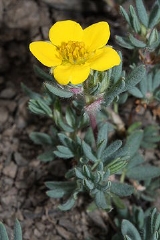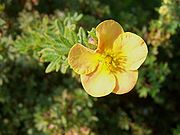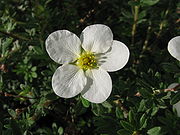
Shrubby Cinquefoil
Encyclopedia
Dasiphora fruticosa is a shrub
in the family Rosaceae
, native to the cool temperate to subarctic regions of the Northern Hemisphere
, often growing at high altitudes in mountain
s.
It is a deciduous
, much branched flowering shrub growing to 0.1–1 m tall, rarely up to 1.5 m. The habit is variably upright to sprawling or prostrate, but stems are often ascending especially those stems with many long branches. The bark
of older stems is shreddy with long thin strips. The plants are densely leafy, the leaves
are divided into five or seven (occasionally three or nine) pinnate leaflets. The leaflets are linear-oblong, 3–20 mm long, with entire margins and more or less acute ends. The foliage (both leaves and young stems) is pubescent, variably covered in fine silky, silvery hairs about 1 mm long. The flower
s are produced terminally on the stems and are 2–3 (–4) cm across, buttercup-shaped, with five petals and 15–25 stamens; the petals are pale to bright yellow (orange to reddish in some western Chinese populations). The fruit
is a cluster of achene
s covered with long hairs. The species is variably dioecious
or bisexual
; flowering is typically from early to late summer. It is normally found growing in moisture retentive soils in swamps and moist rocky areas.
There are two subspecies
:
A number of varieties have been described from Asia, some of which have not yet been published under the genus Dasiphora, and others in that genus only as distinct species. These include Potentilla fruticosa var. albicans Rehd. & Wils., P. f. var. arbuscula (D.Don) Maxim. (syn. Dasiphora arbuscula (D.Don) Soják), P. f. var. dahurica (Nestl.) Ser. (syn. Dasiphora dahurica (Nestl.) Komarov), P. f. var. pumila J.D.Hooker, P. f. var. mandschurica (Maxim.) Wolf (syn. Dasiphora mandshurica (Maxim.) Juz.), and P. f. var. unifoliolata Ludlow (syn. Dasiphora unifoliolata (Ludlow) Soják). The varieties D. f. var. monticola Rydb. and D. f. var. tenuiloba Rydb. have been described from western North America, but are not widely accepted as distinct.
The species is also occasionally known as Tundra-rose and Widdy.

 Shrubby Cinquefoil is a popular ornamental plant
Shrubby Cinquefoil is a popular ornamental plant
throughout the cooler regions of Europe
, the United States
and Canada
. Different cultivar
s are variable with flowers ranging from white to yellow, orange and pink, but they are all hardy plants that produce flowers for much of the summer. The flowers are always small, flat, and round, but there are many dozens on each bush. It is very often used by cities and businesses for landscaping because of its hardiness and low maintenance. It was introduced into cultivation in the 18th century, but many of the modern cultivars, particularly those with orange or red flowers, derive from collections by Reginald Farrer
in western China in the early 20th century. Plants are most often still grown and sold under the old name Potentilla fruticosa.
The Cinquefoil with all its characteristics of small leaves, delicate flowers, and orange to brown flaky bark make it a delightful Bonsai and is very popular in Japan and is gaining popularity in Europe.
Over 130 cultivars have been named; some of the more recommended current cultivars include:
Shrub
A shrub or bush is distinguished from a tree by its multiple stems and shorter height, usually under 5–6 m tall. A large number of plants may become either shrubs or trees, depending on the growing conditions they experience...
in the family Rosaceae
Rosaceae
Rosaceae are a medium-sized family of flowering plants, including about 2830 species in 95 genera. The name is derived from the type genus Rosa. Among the largest genera are Alchemilla , Sorbus , Crataegus , Cotoneaster , and Rubus...
, native to the cool temperate to subarctic regions of the Northern Hemisphere
Northern Hemisphere
The Northern Hemisphere is the half of a planet that is north of its equator—the word hemisphere literally means “half sphere”. It is also that half of the celestial sphere north of the celestial equator...
, often growing at high altitudes in mountain
Mountain
Image:Himalaya_annotated.jpg|thumb|right|The Himalayan mountain range with Mount Everestrect 58 14 160 49 Chomo Lonzorect 200 28 335 52 Makalurect 378 24 566 45 Mount Everestrect 188 581 920 656 Tibetan Plateaurect 250 406 340 427 Rong River...
s.
It is a deciduous
Deciduous
Deciduous means "falling off at maturity" or "tending to fall off", and is typically used in reference to trees or shrubs that lose their leaves seasonally, and to the shedding of other plant structures such as petals after flowering or fruit when ripe...
, much branched flowering shrub growing to 0.1–1 m tall, rarely up to 1.5 m. The habit is variably upright to sprawling or prostrate, but stems are often ascending especially those stems with many long branches. The bark
Bark
Bark is the outermost layers of stems and roots of woody plants. Plants with bark include trees, woody vines and shrubs. Bark refers to all the tissues outside of the vascular cambium and is a nontechnical term. It overlays the wood and consists of the inner bark and the outer bark. The inner...
of older stems is shreddy with long thin strips. The plants are densely leafy, the leaves
Leaf
A leaf is an organ of a vascular plant, as defined in botanical terms, and in particular in plant morphology. Foliage is a mass noun that refers to leaves as a feature of plants....
are divided into five or seven (occasionally three or nine) pinnate leaflets. The leaflets are linear-oblong, 3–20 mm long, with entire margins and more or less acute ends. The foliage (both leaves and young stems) is pubescent, variably covered in fine silky, silvery hairs about 1 mm long. The flower
Flower
A flower, sometimes known as a bloom or blossom, is the reproductive structure found in flowering plants . The biological function of a flower is to effect reproduction, usually by providing a mechanism for the union of sperm with eggs...
s are produced terminally on the stems and are 2–3 (–4) cm across, buttercup-shaped, with five petals and 15–25 stamens; the petals are pale to bright yellow (orange to reddish in some western Chinese populations). The fruit
Fruit
In broad terms, a fruit is a structure of a plant that contains its seeds.The term has different meanings dependent on context. In non-technical usage, such as food preparation, fruit normally means the fleshy seed-associated structures of certain plants that are sweet and edible in the raw state,...
is a cluster of achene
Achene
An achene is a type of simple dry fruit produced by many species of flowering plants. Achenes are monocarpellate and indehiscent...
s covered with long hairs. The species is variably dioecious
Plant sexuality
Plant sexuality covers the wide variety of sexual reproduction systems found across the plant kingdom. This article describes morphological aspects of sexual reproduction of plants....
or bisexual
Plant sexuality
Plant sexuality covers the wide variety of sexual reproduction systems found across the plant kingdom. This article describes morphological aspects of sexual reproduction of plants....
; flowering is typically from early to late summer. It is normally found growing in moisture retentive soils in swamps and moist rocky areas.
There are two subspecies
Subspecies
Subspecies in biological classification, is either a taxonomic rank subordinate to species, ora taxonomic unit in that rank . A subspecies cannot be recognized in isolation: a species will either be recognized as having no subspecies at all or two or more, never just one...
:
- Dasiphora fruticosa subsp. fruticosa. Described from YorkshireYorkshireYorkshire is a historic county of northern England and the largest in the United Kingdom. Because of its great size in comparison to other English counties, functions have been increasingly undertaken over time by its subdivisions, which have also been subject to periodic reform...
, EnglandEnglandEngland is a country that is part of the United Kingdom. It shares land borders with Scotland to the north and Wales to the west; the Irish Sea is to the north west, the Celtic Sea to the south west, with the North Sea to the east and the English Channel to the south separating it from continental...
and ÖlandÖland' is the second largest Swedish island and the smallest of the traditional provinces of Sweden. Öland has an area of 1,342 km² and is located in the Baltic Sea just off the coast of Småland. The island has 25,000 inhabitants, but during Swedish Midsummer it is visited by up to 500,000 people...
, SwedenSwedenSweden , officially the Kingdom of Sweden , is a Nordic country on the Scandinavian Peninsula in Northern Europe. Sweden borders with Norway and Finland and is connected to Denmark by a bridge-tunnel across the Öresund....
. Northern EuropeEuropeEurope is, by convention, one of the world's seven continents. Comprising the westernmost peninsula of Eurasia, Europe is generally 'divided' from Asia to its east by the watershed divides of the Ural and Caucasus Mountains, the Ural River, the Caspian and Black Seas, and the waterways connecting...
(scattered, in Estonia, Great Britain, Ireland, Latvia, and Sweden) and northern and central AsiaAsiaAsia is the world's largest and most populous continent, located primarily in the eastern and northern hemispheres. It covers 8.7% of the Earth's total surface area and with approximately 3.879 billion people, it hosts 60% of the world's current human population...
. - Dasiphora fruticosa subsp. floribunda (Pursh) Kartesz (syn. Potentilla floribunda Pursh., Dasiphora floribunda (Pursh) Raf., Pentaphylloides floribunda (Pursh) A.Love). Described from CanadaCanadaCanada is a North American country consisting of ten provinces and three territories. Located in the northern part of the continent, it extends from the Atlantic Ocean in the east to the Pacific Ocean in the west, and northward into the Arctic Ocean...
, New YorkNew YorkNew York is a state in the Northeastern region of the United States. It is the nation's third most populous state. New York is bordered by New Jersey and Pennsylvania to the south, and by Connecticut, Massachusetts and Vermont to the east...
, and New JerseyNew JerseyNew Jersey is a state in the Northeastern and Middle Atlantic regions of the United States. , its population was 8,791,894. It is bordered on the north and east by the state of New York, on the southeast and south by the Atlantic Ocean, on the west by Pennsylvania and on the southwest by Delaware...
, North AmericaNorth AmericaNorth America is a continent wholly within the Northern Hemisphere and almost wholly within the Western Hemisphere. It is also considered a northern subcontinent of the Americas...
. Asia, southern Europe (Spain east to Bulgaria), and North America.
A number of varieties have been described from Asia, some of which have not yet been published under the genus Dasiphora, and others in that genus only as distinct species. These include Potentilla fruticosa var. albicans Rehd. & Wils., P. f. var. arbuscula (D.Don) Maxim. (syn. Dasiphora arbuscula (D.Don) Soják), P. f. var. dahurica (Nestl.) Ser. (syn. Dasiphora dahurica (Nestl.) Komarov), P. f. var. pumila J.D.Hooker, P. f. var. mandschurica (Maxim.) Wolf (syn. Dasiphora mandshurica (Maxim.) Juz.), and P. f. var. unifoliolata Ludlow (syn. Dasiphora unifoliolata (Ludlow) Soják). The varieties D. f. var. monticola Rydb. and D. f. var. tenuiloba Rydb. have been described from western North America, but are not widely accepted as distinct.
The species is also occasionally known as Tundra-rose and Widdy.
Cultivation and uses


Ornamental plant
Ornamental plants are plants that are grown for decorative purposes in gardens and landscape design projects, as house plants, for cut flowers and specimen display...
throughout the cooler regions of Europe
Europe
Europe is, by convention, one of the world's seven continents. Comprising the westernmost peninsula of Eurasia, Europe is generally 'divided' from Asia to its east by the watershed divides of the Ural and Caucasus Mountains, the Ural River, the Caspian and Black Seas, and the waterways connecting...
, the United States
United States
The United States of America is a federal constitutional republic comprising fifty states and a federal district...
and Canada
Canada
Canada is a North American country consisting of ten provinces and three territories. Located in the northern part of the continent, it extends from the Atlantic Ocean in the east to the Pacific Ocean in the west, and northward into the Arctic Ocean...
. Different cultivar
Cultivar
A cultivar'Cultivar has two meanings as explained under Formal definition. When used in reference to a taxon, the word does not apply to an individual plant but to all those plants sharing the unique characteristics that define the cultivar. is a plant or group of plants selected for desirable...
s are variable with flowers ranging from white to yellow, orange and pink, but they are all hardy plants that produce flowers for much of the summer. The flowers are always small, flat, and round, but there are many dozens on each bush. It is very often used by cities and businesses for landscaping because of its hardiness and low maintenance. It was introduced into cultivation in the 18th century, but many of the modern cultivars, particularly those with orange or red flowers, derive from collections by Reginald Farrer
Reginald Farrer
Reginald John Farrer , was a traveller and plant collector. He published a number of books, although is best known for My Rock Garden...
in western China in the early 20th century. Plants are most often still grown and sold under the old name Potentilla fruticosa.
The Cinquefoil with all its characteristics of small leaves, delicate flowers, and orange to brown flaky bark make it a delightful Bonsai and is very popular in Japan and is gaining popularity in Europe.
Over 130 cultivars have been named; some of the more recommended current cultivars include:
- 'Abbotswood' - large white flowers and bluish green foliage. RHS Award of Garden Merit.
- 'Beanii' - green foliage and white flowers.
- 'Coronation Triumph' - medium-bright yellow flowers, plants are drought- and cold-tolerant and heavy bloomers.
- 'Daydawn' - salmon-pink flowers. RHS Award of Garden Merit.
- 'Day Dawn Viette' - peach-soft rose flowers highlighted with cream.
- 'Elizabeth' - yellow flowers to 3.5 cm diameter.
- 'Farreri' - leaves mostly with seven leaflets, flowers golden yellow.
- 'Farrer's White' - as 'Farreri', but with white flowers.
- 'Goldfinger' - deep golden-yellow flowers on plants with dark green foliage, good plant form and heavy flowering.
- 'Katherine Dykes' - gracefully arching branches with lemon-yellow flowers, medium green foliage. Needs regular trimming to keep from becoming leggy.
- 'Klondike' - large bright yellow flowers, 3.5–4 cm diameter.
- 'Maanelys' ('Moonlight') - leaves blue-green, flowers pale yellow.
- 'Mckay's White' - creamy white flowers
- 'Mount Everest' - flowers large, 3-3.5 cm, white.
- 'Pink Queen' - pink flowers.
- 'Primrose Beauty' - pale yellow flowers, silver tinted foliage. A good performer in the landscape with good habit and blooming, introduced in the Netherlands in 1955. RHS Award of Garden Merit.
- 'Pyrenaica' - prostrate, to 20 cm tall; leaves mostly with three leaflets; flowers golden yellow.
- 'Red Ace' - bushy, upright shrub bearing profusions of single bright orange flowers from early summer to first frost. RHS Award of Garden Merit.
- 'Snowbird' - double flowers with 12–15 white petals. Blooms more than 'Abbotswood' and has dark green foliage.
- 'Tangerine' - as 'Farreri', but with orange-red flowers.
- 'Vilmoriniana' - vigorous, to 1.3 m tall; leaves grey-white hairy, flowers ivory white to pale yellow.
- 'Walton Park' - flowers very large, 3.5–4 cm, golden yellow.
- 'William Purdom' - leaves mostly with seven leaflets, flowers pale yellow.
- 'Yellow Bird' - bright yellow semi-double flowers with 8–10 petals. Medium green foliage and winter hardy, introduced from University of Manitoba. RHS Award of Garden Merit.

